Sometimes with new recipes I move in a straight line: a quick period of testing, a result that mostly pleases. It’s rare, but here is one example.
Pain au raisin is my favorite danish. Swirls of dough, just enough pastry cream, and aromatic raisins for substance — it’s unrivaled.
This version has a couple twists. I use laminated brioche (remember this from the Suprèmes?) flavored with orange zest. The dough is rolled up with pastry cream, garnished with wine-soaked yellow raisins and — rather than using apricot jelly for glaze after the bake — I reduce fresh orange juice and brush it on for a little more orange aroma.
If you made the Suprèmes you may remember that I’ve streamlined the brioche lamination process (it’s not too bad!). That, with a couple other tweaks, brings some ease to a famously difficult process. With my changes on board the entire project comes together in a scant half day.
So let’s get to the recipe.
If you’re enjoying the newsletter, please tell your friends, share, sign up, and so forth. Your support is felt and appreciated! I love a comment, a repost, or a tag if you make it. It’s great to know you’re out there. And thank you.
Pain au Raisin
Yeast, dry instant, 13.4g (4.5 t)
Water, 27g (in cool months use warm)
Eggs, whole, 149g (three large eggs, room temperature, best quality)
To the bowl of a stand mixer add the yeast, water, and eggs. Whisk vigorously by hand to combine. Note: This allows the yeast to hydrate before adding the remaining ingredients. If you skip this step you may see flecks of unactivated yeast in the dough after mixing.
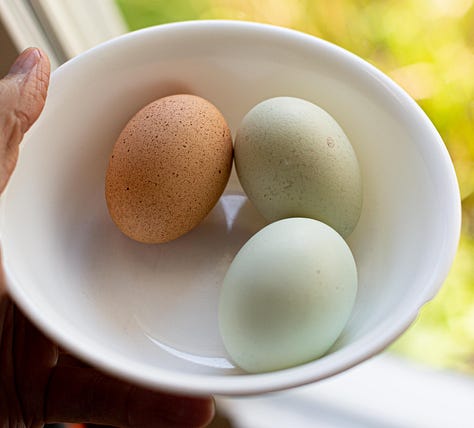
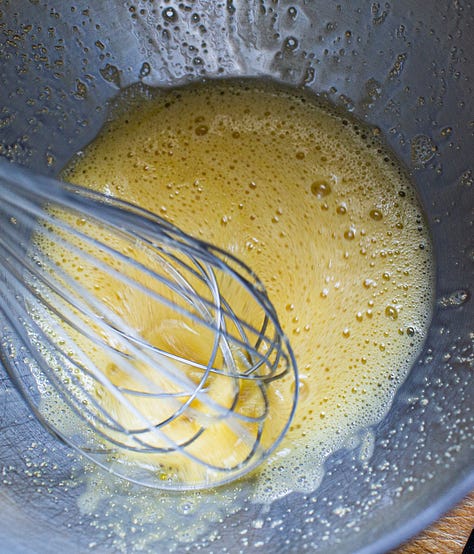
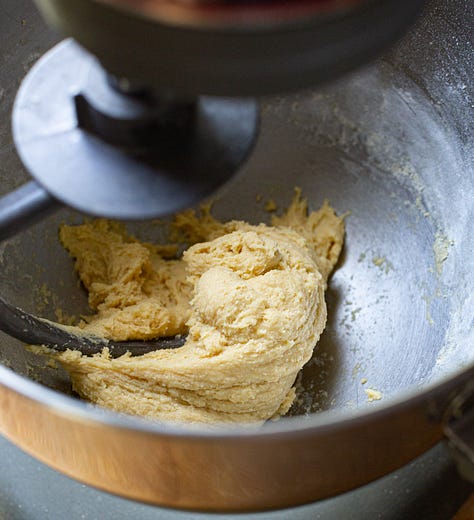
Bread flour, 12.7%, 298g
Salt, fine, 7g
Sugar, granulated, 30g
Orange zest, 5g (zest of one large orange)
Butter, unsalted, soft, 71g
Add the flour, salt, sugar, zest, and soft butter to the yeast slurry and mix on medium (speed 4 in my KitchenAid 6 qt. stand mixer) with a dough hook for 7 minutes, scraping as necessary. The mixture will begin as a slightly crumbly mess before starting to stick to the bottom of the bowl (keep scraping to help it release), and then finally ending by climbing the hook (scrape it down off the hook to ensure that it’s actually mixing, not merely spinning around the bowl).
At the end of mixing the dough will be smooth, elastic, and will clean the bowl. Check the dough’s temperature after mixing: it should be between 70 and 75˚F. If it’s warmer than 75˚F, place it in a cool location. If it’s cooler than 70˚F, place it someplace warm.
Cover and set to rise at room temperature (72 to 74˚F) for 1 to 1.5 hours. During the rise the dough will puff slightly but not necessarily double in size.
While the dough proofs make the pastry cream, and soak the raisins (recipes below).
After the first rise, dump the dough out of the bowl onto a lightly floured surface. Lightly flour the top then press, stretch, and roll into an exact rectangle, 7” by 16”. Cover tightly, place on a sheet tray, and freeze for 20 minutes.
Butter, unsalted, 225g, room temperature
While the dough chills, prepare the butter block. Fold a half sheet of parchment to form a rectangle with closed top and sides measuring exactly 8” by 11”. Add the room temperature butter to the center of the rectangle and flatten to a thin layer using the heel of your hand. Don’t worry about the corners, you’ll take care of those in the next step. Close the paper over the butter and further smear into the corners with a rolling pin.
Freeze the butter for 5 minutes or so, it won’t take long to become firm.
Remove the dough and butter from the freezer. On a lightly floured surface roll the dough to 8.5” wide and 22.5” long, doing your best to square the corners (stretch them gently with your hands if necessary). Gently peel open one side of the butter block and place, butter side down, atop the dough. In cooler months, let it rest briefly as it warms and becomes pliable, a minute or so. In warmer months it may not be necessary to wait. Fold the dough piece to cover the butter and press to seal. Pierce any air bubbles. After adding the butter and folding in the sides the dough piece should measure 8.75" by 11.5".
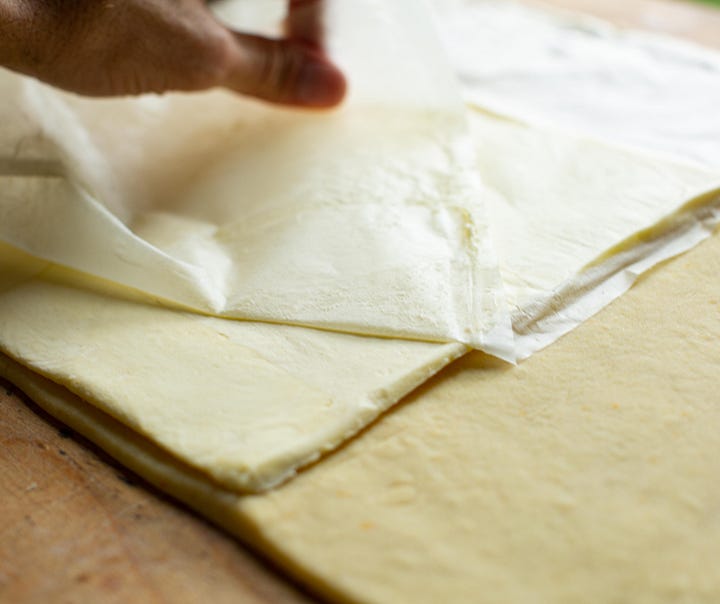
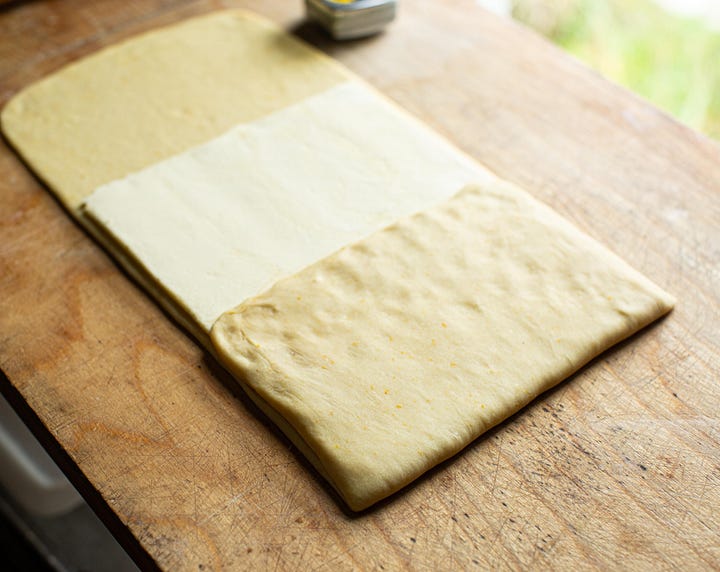
Gently and evenly roll the mass to 22” in length, being careful to keep the dough piece narrow, roughly 10” wide. (If it spreads to 11”, it’s ok.)
Dust any bench flour off the dough then perform a book fold by folding the ends of the piece to the middle and then folding the ends to the middle a second time. The dimension of the dough block after the book fold should be roughly 11” long by 5.25” wide. (If the book fold (“double fold”) or the letter fold (“single fold”) are confusing or unfamiliar, there are good videos on YouTube that show the process better than they can be described with words.)
Turn the dough 90˚ and roll to 27” by 7”. Trim the ends to square them off. Dust to remove any bench flour, then perform a letter fold and press the layers to seal. After the letter fold the dough should measure 9.5” by 6.5”.
Gently roll the dough to flatten, aiming for roughly 12" by 7". Cover well (I fold mine up inside the parchment I used for the butter block), and chill in the refrigerator until cool, 20 minutes.
After the chill the dough should be firm but pliable.
Roll the dough to a width of 18" and a height of at least 14".
Add the pastry cream in a thin layer, leaving an inch or so without cream at the near edge.
Add the raisins.

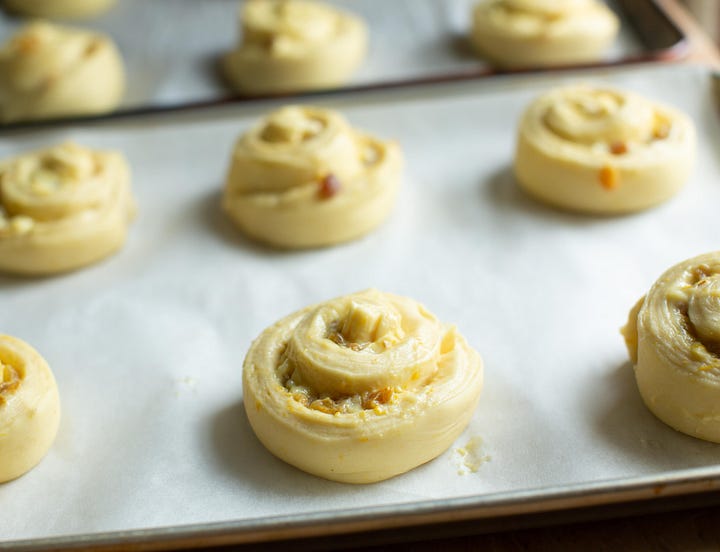
Roll up, seal (brush the blank portion of the dough at the near edge with egg or water) and cut into 1.5" pieces, 12 total.
Proof covered for 60 to 90 minutes. Preheat the oven to 425°F about 30 minutes before baking.
While the rolls proof, prepare the orange glaze (recipe below).
When the rolls are light to the touch and “marshmallowy”, egg wash and load. Immediately reduce the oven to 400°F and bake for 14 to 16 minutes or until deep golden brown, rotating as necessary. The rolls will take color easily — I encourage you to embrace this. A full bake gives better crispness and flake.
Immediately brush with the warm glaze, serve, and enjoy. Any leftovers may be heated through and served at a later point. They should freeze and reheat well.
Pastry cream
Milk, whole or 2%, 345g
In a small pot bring the milk to a simmer.
Sugar, granulated, 75g
Cornstarch, 21g
Salt, 1g (big pinch)
Egg yolks, 54g (three yolks, best quality)
While the milk heats (keep a close eye on it), stir together the sugar, cornstarch, and salt in a medium bowl. Add the egg yolks and whisk until homogenous.
Add half the warm milk to the egg mixture to temper it. Stir vigorously to combine, then whisk the tempered milk and yolk mixture back into the pot.
Return to the heat and stir constantly until thickened.
Butter, unsalted, 21g
Vanilla, 10g
Remove from the heat and stir in the butter and vanilla. Reserve at room temperature until use. The pastry cream should be fully set before spreading onto the pastry. Whisk until smooth before spreading.
Raisin soaker
Raisins, yellow, 150g
White wine, 50g (or 15g vanilla (1 T) plus 35g water)
Orange zest, 4g (1 T) (Zest of one medium large orange)
Combine everything in a small bowl and stir to coat and hydrate. Give the mixture a couple hours for the raisins to take up the liquid.
Orange glaze
Orange juice, 160g (two large oranges, *use the ones that you zested for the dough)
Sugar, granulated, 25g
Juice the oranges, strain, and add the liquid to a small pot over medium low heat.
Stir in the sugar then slowly reduce for 10 minutes or so, stirring, until the mixture is reduced to the consistency of thick syrup.
Reserve until use.




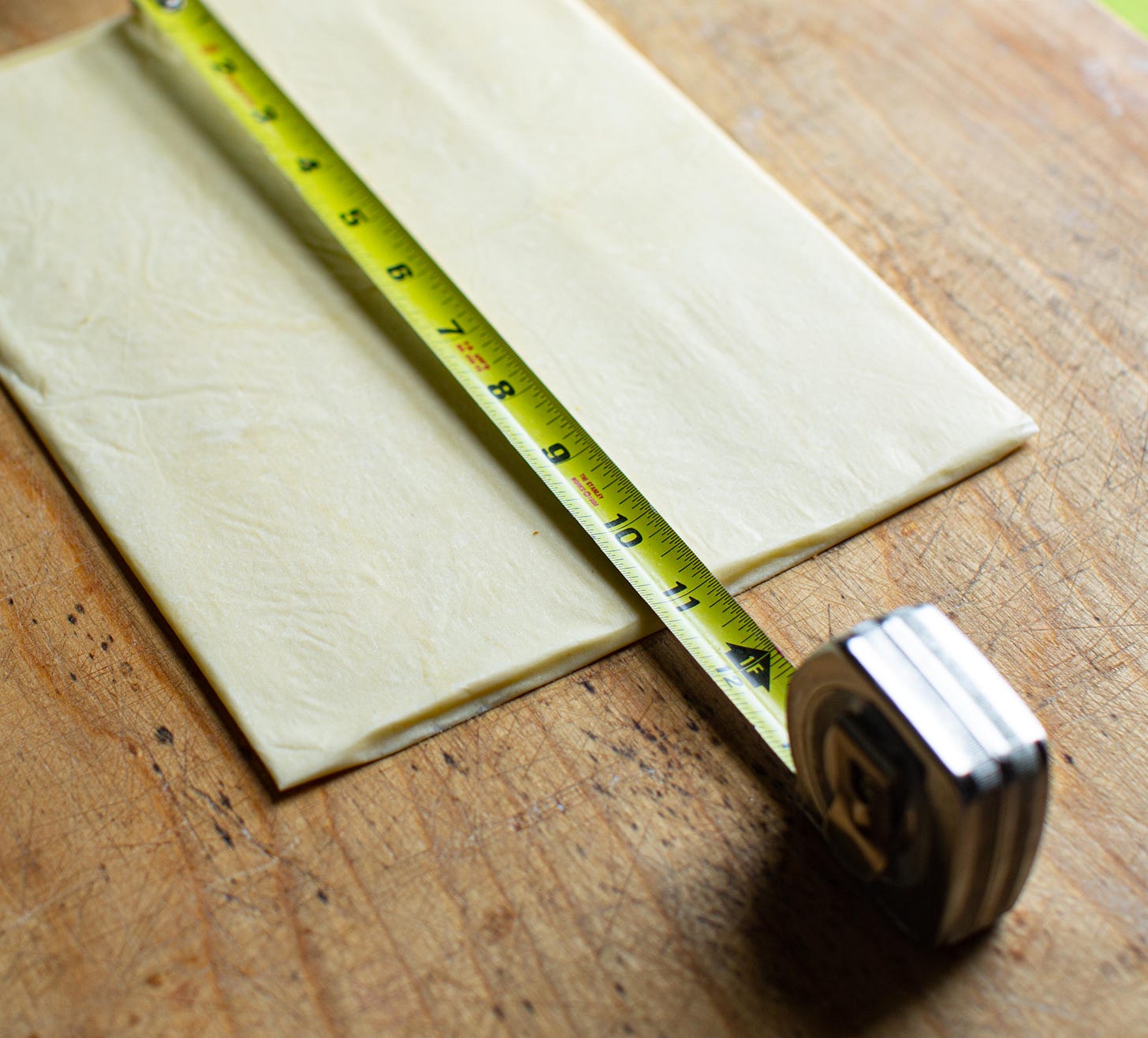



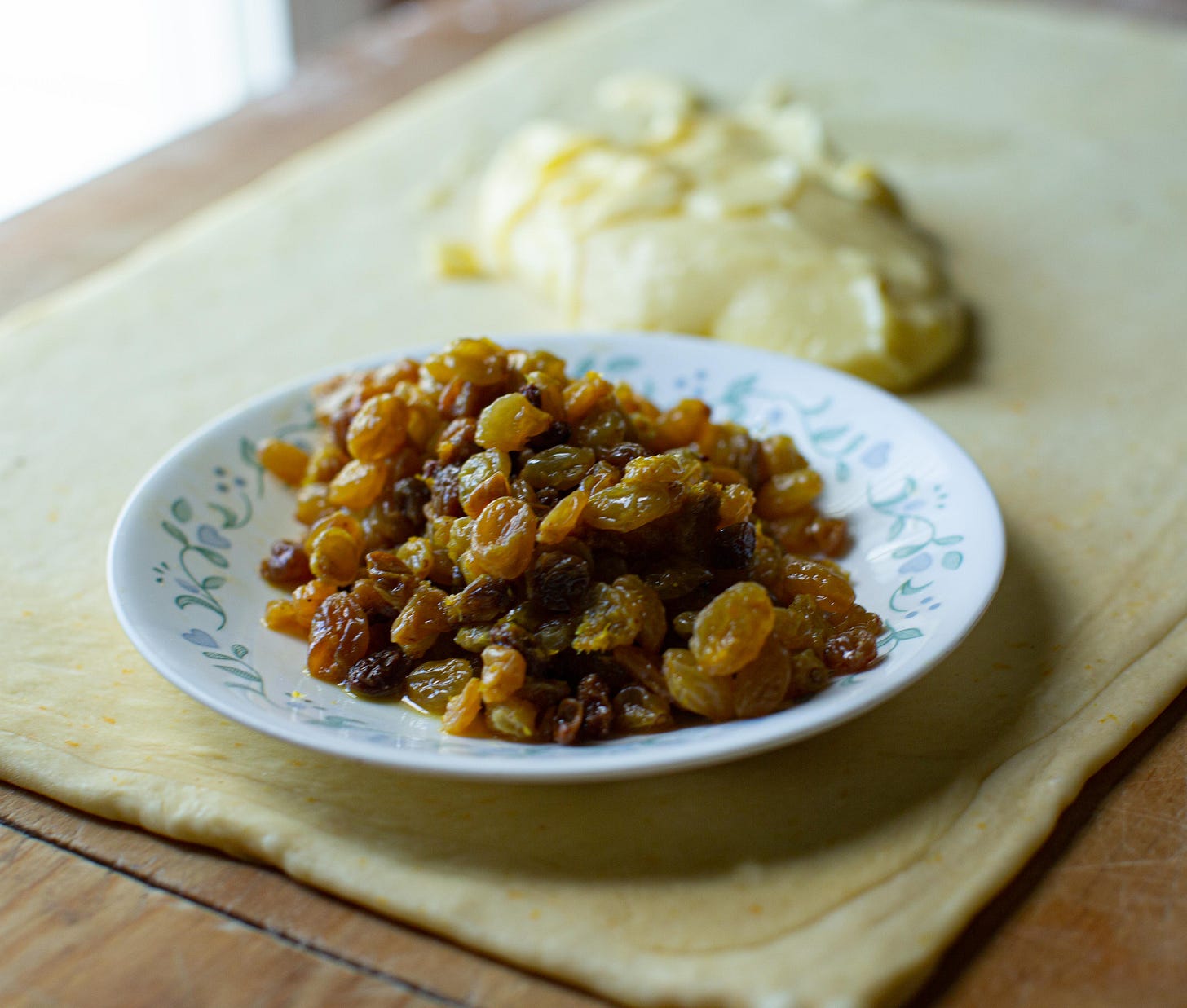
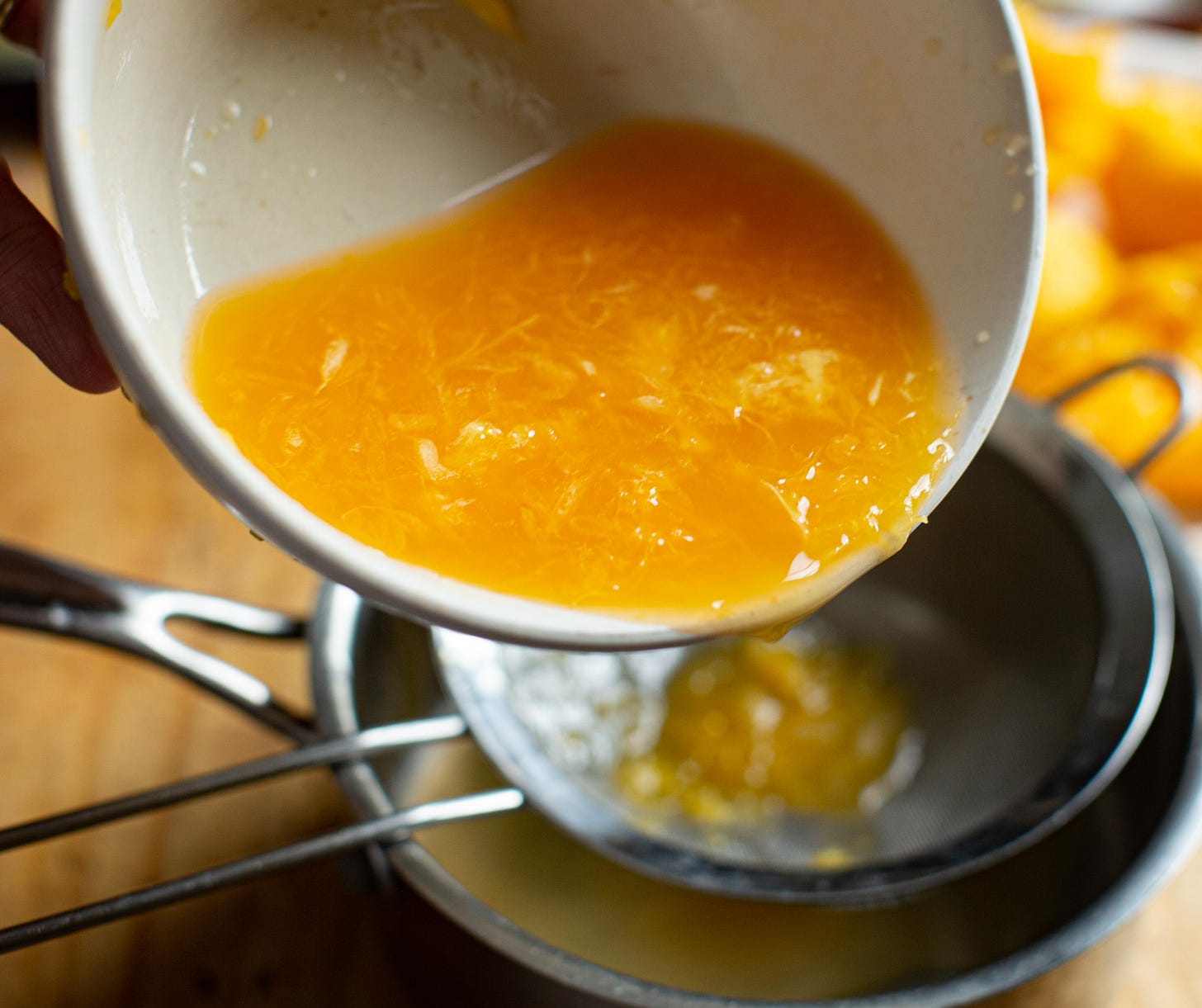
Amazing recipe! I tried other laminated dough recipes before without much success. Followed your recipe and instructions to a T and my Pain au raisin turned out great! Thank you so much! Looking forward to trying out the rest of your recipes.
Thank you so much for this recipe! I subbed mini chocolate chips for the raisins and brushed them in homemade apricot vanilla jam. The directions for laminating were so easy to follow and worked better than all the other recipes I’ve done at home.